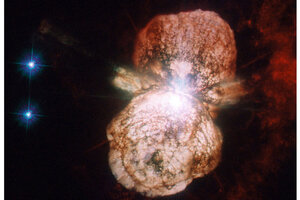NASA unravels mysteries of huge space explosion
Astronomers have created 3-D models of the binary system Eta Carina, which a century and a half ago began ejecting massive amounts of hot gaseous material.

The huge clouds of matter thrown out by the binary star system Eta Carinae have been a regular target for the Hubble Space Telescope since its launch in 1990.
ESA/Hubble & NASA
In the constellation of Carina, lies the most luminous and mysterious star system within 10,000 light-years. The two massive stars, better known as Eta Carinae, erupted twice in the 19th Century for reasons astronomers still don’t understand, and are now approaching the point where one might soon detonate as a supernova.
Astronomers from the 225th meeting of the American Astronomical Society weighed in on this supermassive showoff earlier today. New findings include 3-D printed models that reveal never-before-seen features of the stars’ interactions.
But first, let’s better orient ourselves with this elusive system. The brighter, primary star has about 90 times the mass of the Sun and outshines it five million times. The properties of the smaller, companion star are still hotly contested. Both stars produce powerful gaseous outflows called stellar winds. Although these winds enshroud the stars, blocking all efforts to directly observe them, the gas is hot and dense enough to emit observable X-rays.
The X-ray emission, however, dramatically changes when the stars reach their point of closest approach, or periastron. As the stars approach one another, their X-ray output gradually brightens, reaching a maximum when the stars are as close as Mars is to the Sun. But just past periastron, the X-rays drop suddenly as the companion star quickly moves around the primary star.
Now, a research team has developed a 3-D simulation, looking at 11 years worth of data and three periastron passages, from multiple NASA satellites and ground-based telescopes.
According to the team’s model, the winds from each star have different properties. The primary star’s winds are extremely slow, blowing out at one million miles per hour, while the hotter companion star’s winds are much faster, clocking in at a speed six times greater. The primary star’s winds are also extremely dense, carrying away the equivalent mass of our Sun every thousand years, while the companion’s wind carries off 100 times less material.
But the research team didn’t stop there. “Using a commercial 3-D printer … we have found a way to 3-D print the output from our computer simulations of Eta Car,” said Thomas Madura, also from NASA Goddard Space Flight Center. “And as far as we are aware these are the world’s first 3-D prints of a supercomputer simulation of a complex astrophysical system.”
The printed model can be separated into two sections: the dense wind from the primary star and the more tenuous wind from the companion star. Slicing the model in half therefore reveals the cavity carved by the companion star’s wind into the primary star’s wind.
“As a result of doing this 3-D printing work, we actually discovered these finger-like protrusions that extend radially out of the spiral wind-wind collision region,” said Madura. “These are features that we didn’t even really know existed” prior to this. They’re likely the result of physical instabilities that arise when the fast wind collides with the slower wind, which is essentially a wall of gas.
Both of the massive stars of Eta Carinae might one day end their lives in supernova explosions. “For stars, mass determines their destiny. But for massive stars, mass loss determines their destiny,” said Michael Corcoran from the NASA Goddard Space Flight Center.
Although the stars continue to lose mass at high rates, there is no evidence to suggest an imminent demise of either star.
Shannon Hall is a freelance science journalist. She holds two B.A.'s from Whitman College in physics-astronomy and philosophy, and an M.S. in astronomy from the University of Wyoming. Currently, she is working toward a second M.S. from NYU's Science, Health and Environmental Reporting program. You can follow her on Twitter @ShannonWHall.

